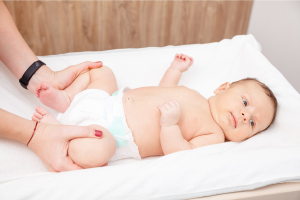Hip Dysplasia (DDH or Developmental dysplasia) in children is a common issue affecting the infant’s hip joints. Most children have no long-term effects or complications if hip dysplasia is treated when the child is six months or younger. This is one of the reasons well check-ups are essential to your growing baby!

DEFENITION:
Developmental dysplasia of the hips (Hip Dysplasia) is used to explain an infant’s hip instability. The femur (long bone of the thigh) and the acetabulum (part of the hip where the femur attaches) can become unstable, leading to long-term problems with the hip.
SYMPTOMS:
At first, the symptoms are only an abnormal “clunk” sound during a maneuver the physician performs at a newborn physical. By two months of age, symptoms can include:
- Different leg lengths
- Inability to fully move the hip
- Asymmetrical skin folds on the thighs
CAUSES:
Multiple factors, including:
- Breech delivery
- Abnormal position in the uterus
- Response to hormonal factors influencing the laxity of the ligaments surrounding the hips
CONTAGION:
Not a contagious illness
DIAGNOSIS:
The diagnosis is made by performing a physical examination followed by an x-ray or ultrasound of the hips in suspicious cases. The physician should check for developmental dysplasia of the hip until a child is walking. The physical examination includes maneuvers of the hip, called the Barlow and Ordolani Maneuver. During this examination, we are looking for discrepancies in leg length, checking for limited hip joint motion, and observing for asymmetrical skin folds in the thighs. The Barlow Maneuver checks to see if the hip can be dislocated. The Ordolani checks to see if a dislocated hip can be relocated. A “clunk” sound during either of these maneuvers is suspicious for hip dysplasia. Once suspicious, an x-ray or ultrasound of the hip can confirm the diagnosis. Ultrasound is becoming more popular and is now the study of choice.
TREATMENT:
The treatment depends on the age when it first develops, the progression of the symptoms, and the response to previous treatment. For newborns, developmental dysplasia of the hips can be observed with no treatment for three to four weeks. Most will resolve spontaneously. If it has not resolved by one month of age, the child can be placed in a Pavlik harness. This harness places the legs and hips in such a position as to promote stabilization of the hip joint. Most children will remain in the harness for a total of four months. If the harness fails, a child can be placed in traction for two to four weeks, or an operation can be done, and the hip can be stabilized with the child placed in a cast called a Spica cast. The Spica cast goes from below the belly button to the thighs, leaving an opening for the diaper. A Spica cast can be worn for two to three months.
OUTCOME:
Most will resolve with observation. If observation fails, the Pavlik harness will cure almost all the remaining cases. Very few children will need to be placed in a Spica cast, and even fewer will have long-term hip complications. Hip replacement may be necessary for a small percentage that fails all treatments, although this is extremely rare.
DISCUSSION:
Developmental dysplasia of the hips used to be called “Congenital Hip Dysplasia,” as it used to be thought that infants were born with this problem. Although some are, others may develop developmental dysplasia of the hips as time progresses. The prevalence of developmental dysplasia of the hips is fifteen children for every 1000 births. It affects six times as many females as males. This is thought to be due to a female’s reaction to maternal estrogen. This reaction can cause the ligaments surrounding the hip joint to become lax, allowing the femur to dislocate from the acetabulum more easily. The earlier this illness can be diagnosed, the better the results. Children who develop developmental dysplasia of the hips later in the first year of life are at higher risk for future complications.
ONE DOCTOR’S OPINION:
The hips must be checked during every physical examination until the child is walking. The hip check causes the most questions during my physical examination. This is because the Barlow and Ordolani Maneuvers almost always make the baby cry, and these maneuvers can cause some pain and discomfort. This makes sense since I’m actually trying to see if I can dislocate the hip joint. However, it is essential to check for this. If it is missed, the child will grow up with life-long hip problems if it doesn’t resolve on its own. Once found, treatment can commence, and the problem can be resolved in almost every case.
This blog was written by Dr. Michael Bornstein, who has 30 years of experience as a pediatrician.
Disclaimer: The contents of this article, including text and images, are for informational purposes only and do not constitute a medical service. Always seek the advice of a physician or other qualified health professional for medical advice, diagnosis, and treatment.


FOLLOW US